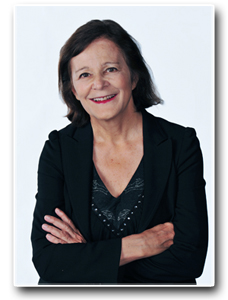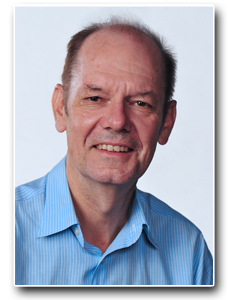|
|
|
|
Invited Speakers
Graphics Interface has two invited speakers from the areas of graphics and human-computer interaction. A two further keynote talks will be given by this year's co-winners of the CHCCS Achievement Award.

Graphics Keynote Title: 3D Image Analysis and Synthesis -- The World Inside the Computer
Speaker: Hans-Peter Seidel, MPI Informatics and Saarland University
Abstract:
During the last three decades computer graphics established
itself as a core discipline within computer science and
information technology. Ten years ago, most digital content
was textual. Today it has expanded to include audio, images,
video, and a variety of graphical representations. New and
emerging technologies such as multimedia, social networks,
digital television, digital photography and the rapid development
of new sensing devices, telecommunication and telepresence,
virtual reality, or 3D-internet further indicate the
potential of computer graphics in the years to come.
Typical for the field is the coincidence of very large
data sets with the demand for fast, and possibly
interactive, high quality visual feedback. Furthermore,
the user should be able to interact with the environment in
a natural and intuitive way.
In order to address the challenges mentioned above, a new and
more integrated scientific view of computer graphics is required.
In contrast to the classical approach to computer graphics which
takes as input a scene model -- consisting of a set of light
sources, a set of objects (specified by their shape and
material properties), and a camera -- and uses simulation to
compute an image, we like to take the more integrated view of
3D Image Analysis and Synthesis for our research.
We consider the whole pipeline from data acquisition,
over data processing to rendering in our work. In our opinion,
this point of view is necessary in order to exploit the
capabilities and perspectives of modern hardware, both on the
input (sensors, scanners, digital photography, digital video) and
output (graphics hardware, multiple platforms) side. Our vision
and long term goal is the development of methods and tools to
efficiently handle the huge amount of data during the acquisition
process, to extract structure and meaning from the abundance
of digital data, and to turn this into graphical representations
that facilitate further processing, rendering, and interaction.
In this presentation I will highlight some of our ongoing research
by means of examples. Topics covered include 3D Reconstruction and Digital
Geometry Processing (both for urban and non-urban environments), Motion and
Performance Capture, 3D video processing, and Multimodal Music Processing.
Short Biography:
Hans-Peter Seidel is the scientific director and chair of the computer
graphics group at the Max Planck Institute (MPI) for Informatics and
a professor of computer science at Saarland University, Saarbr¸cken, Germany.
Seidel's group has done pioneering work in the newly emerging area of 3D
image analysis and synthesis, on the intersection between computer graphics
and computer vision, considering the whole pipeline from data acquisition
to rendering. His long term goal has been the development of methods and
tools to efficiently handle the huge amount of data during the acquisition
process (geometry, appearance, time-varying data), to extract structure
and meaning from this abundance of digital data, and to turn this into
graphical respresentations that facilitate further processing, rendering,
and interaction. For his work Seidel has been awarded the DFG Leibniz Prize
in 2003.
Seidel has been on the program committee of all major international graphics
conferences, and chaired several of these events. He has extensively
published in the field (including more than 30 papers at ACM Siggraph and
more than 50 papers at Eurographics), and more than 20 former members
of his group have received offers for tenured faculty positions, in Germany
and abroad.
Seidel is co-chair of the Max Planck Center for Visual Computing and
Communication (MPC-VCC) (since 2003), and he is the scientific coordinator of
the Cluster of Excellence on Multimodal Computing and Interaction (M2CI) that
was established by the German Research Foundation (DFG) within the framework
of the German Excellence Initiative in 2007.

Graphics Keynote Title: (Display) Space: The Final Frontier (for Interactive Visual Analytics)
Speaker: Chris North, Virginia Tech
Abstract:
These are exciting times in the universe of user interfaces. New directions in the field are coming together to significantly advance frontiers in enabling people to make sense of large amounts of information. Visual Analytics has established itself as a field that brings together the human intuition of interactive visualization and the computational power of data mining. At the same time, the onset of large high-resolution displays and interaction technologies has the potential to offer vast new opportunities for interactive visual analytics.
How can large high-resolution display spaces help users throughout their analytic processes? What new interaction opportunities are afforded? How and why is interacting with large display spaces fundamentally different than standard desktop displays? How should we design the display systems, visualizations, and interaction techniques to maximize human performance and exploit embodied cognition? What is the relationship between display space and computational data mining? How does this open up new worlds of interaction between humans and mining algorithms?
We will explore recent empirical results of experiments on these questions, seek out new user interface design philosophies, and boldly discuss future directions for visual analytics in the large.
Short Biography:
Dr. Chris North is an Associate Professor of Computer Science at Virginia Tech. He leads the Information Visualization research group in the Center for Human-Computer Interaction, and directs the GigaPixel Display Laboratory, one of the most advanced display and interaction facilities in the world. He was General Chair of the IEEE Information Visualization (InfoVis) Conference, and an associate editor of IEEE Transactions on Visualization and Computer Graphics. He currently serves on the editorial board of the Information Visualization journal, and is a member of the DHS supported VACCINE Visual Analytics Center of Excellence. He was awarded Faculty Fellow of the College of Engineering at Virginia Tech. He regularly teaches graduate courses on Information Visualization and undergraduate courses on Human-Computer Interaction. His research expertise is in human-computer interaction, information visualization, and visual analytics. His recent interests focus on insight-based evaluation methods for visualization, user interfaces for large high-resolution display spaces, and combining interactive visualization with computational data mining. He earned his Ph.D. at the University of Maryland, College Park, in 2000.
The 2012 Achievement Award goes to Prof. Nadia Magnenat Thalmann and Prof. Daniel Thalmann.
 Prof. Nadia Magnenat Thalmann has pioneered research into virtual humans over the last 30 years. She obtained several Bachelor's and Master's degrees in various disciplines (Psychology, Biology and Biochemistry) and a PhD in Quantum Physics from the University of Geneva in 1977. From 1977 to 1989, she was a Professor at the University of Montreal in Canada. From 1989 to 2010, she has been a Professor at the University of Geneva where she founded the interdisciplinary research group MIRALab. Together with her PhD students, she has published more than 550 papers on virtual humans and virtual worlds with applications in 3D clothes, hair, body modelling, emotional virtual humans and social robots and medical simulation of articulations. In 2009, she received a Dr Honoris Causa from the Leibniz University of Hanover in Germany and iIn May 2010, the Distinguished Career Award from the Eurographics. In June 2010, she received an Honorary Doctorate of the University in Ottawa in Canada. She is presently Professor and Director of the Institute for Media Innovation (IMI) at Nanyang Technological University, Singapore and Director of MIRALab at the University of Geneva, Switzerland. She is a life member of the Swiss Academy of Engineering Sciences (SATW). Prof. Nadia Magnenat Thalmann has pioneered research into virtual humans over the last 30 years. She obtained several Bachelor's and Master's degrees in various disciplines (Psychology, Biology and Biochemistry) and a PhD in Quantum Physics from the University of Geneva in 1977. From 1977 to 1989, she was a Professor at the University of Montreal in Canada. From 1989 to 2010, she has been a Professor at the University of Geneva where she founded the interdisciplinary research group MIRALab. Together with her PhD students, she has published more than 550 papers on virtual humans and virtual worlds with applications in 3D clothes, hair, body modelling, emotional virtual humans and social robots and medical simulation of articulations. In 2009, she received a Dr Honoris Causa from the Leibniz University of Hanover in Germany and iIn May 2010, the Distinguished Career Award from the Eurographics. In June 2010, she received an Honorary Doctorate of the University in Ottawa in Canada. She is presently Professor and Director of the Institute for Media Innovation (IMI) at Nanyang Technological University, Singapore and Director of MIRALab at the University of Geneva, Switzerland. She is a life member of the Swiss Academy of Engineering Sciences (SATW).
Keynote Title: The Physiological Virtual Human
|
 Prof. Daniel Thalmann is with the Institute for Media Innovation at the Nanyang Technological University in Singapore. He is a pioneer in research on Virtual Humans. His current research interests include Real-time Virtual Humans in Virtual Reality, crowd simulation, and 3D Interaction. Daniel Thalmann has been the Founder of The Virtual Reality Lab (VRlab) at EPFL. He is coeditor-in-chief of the Journal of Computer Animation and Virtual Worlds, and member of the editorial board of 6 other journals. Daniel Thalmann was member of numerous Program Committees, Program Chair and CoChair of several conferences including IEEE VR, ACM VRST, and ACM VRCAI. Daniel Thalmann has published more than 500 papers in Graphics, Animation, and Virtual Reality. He is coeditor of 30 books, and coauthor of several books including 'Crowd Simulation' and 'Stepping Into Virtual Reality', published in 2007 by Springer. He received his PhD in Computer Science in 1977 from the University of Geneva and an Honorary Doctorate (Honoris Causa) from University Paul- Sabatier in Toulouse, France, in 2003. He also received the Eurographics Distinguished Career Award in 2010. Prof. Daniel Thalmann is with the Institute for Media Innovation at the Nanyang Technological University in Singapore. He is a pioneer in research on Virtual Humans. His current research interests include Real-time Virtual Humans in Virtual Reality, crowd simulation, and 3D Interaction. Daniel Thalmann has been the Founder of The Virtual Reality Lab (VRlab) at EPFL. He is coeditor-in-chief of the Journal of Computer Animation and Virtual Worlds, and member of the editorial board of 6 other journals. Daniel Thalmann was member of numerous Program Committees, Program Chair and CoChair of several conferences including IEEE VR, ACM VRST, and ACM VRCAI. Daniel Thalmann has published more than 500 papers in Graphics, Animation, and Virtual Reality. He is coeditor of 30 books, and coauthor of several books including 'Crowd Simulation' and 'Stepping Into Virtual Reality', published in 2007 by Springer. He received his PhD in Computer Science in 1977 from the University of Geneva and an Honorary Doctorate (Honoris Causa) from University Paul- Sabatier in Toulouse, France, in 2003. He also received the Eurographics Distinguished Career Award in 2010.
Keynote Title: Virtual Humans: From One to Many
|
|



 Prof. Nadia Magnenat Thalmann has pioneered research into virtual humans over the last 30 years. She obtained several Bachelor's and Master's degrees in various disciplines (Psychology, Biology and Biochemistry) and a PhD in Quantum Physics from the University of Geneva in 1977. From 1977 to 1989, she was a Professor at the University of Montreal in Canada. From 1989 to 2010, she has been a Professor at the University of Geneva where she founded the interdisciplinary research group MIRALab. Together with her PhD students, she has published more than 550 papers on virtual humans and virtual worlds with applications in 3D clothes, hair, body modelling, emotional virtual humans and social robots and medical simulation of articulations. In 2009, she received a Dr Honoris Causa from the Leibniz University of Hanover in Germany and iIn May 2010, the Distinguished Career Award from the Eurographics. In June 2010, she received an Honorary Doctorate of the University in Ottawa in Canada. She is presently Professor and Director of the Institute for Media Innovation (IMI) at Nanyang Technological University, Singapore and Director of MIRALab at the University of Geneva, Switzerland. She is a life member of the Swiss Academy of Engineering Sciences (SATW).
Prof. Nadia Magnenat Thalmann has pioneered research into virtual humans over the last 30 years. She obtained several Bachelor's and Master's degrees in various disciplines (Psychology, Biology and Biochemistry) and a PhD in Quantum Physics from the University of Geneva in 1977. From 1977 to 1989, she was a Professor at the University of Montreal in Canada. From 1989 to 2010, she has been a Professor at the University of Geneva where she founded the interdisciplinary research group MIRALab. Together with her PhD students, she has published more than 550 papers on virtual humans and virtual worlds with applications in 3D clothes, hair, body modelling, emotional virtual humans and social robots and medical simulation of articulations. In 2009, she received a Dr Honoris Causa from the Leibniz University of Hanover in Germany and iIn May 2010, the Distinguished Career Award from the Eurographics. In June 2010, she received an Honorary Doctorate of the University in Ottawa in Canada. She is presently Professor and Director of the Institute for Media Innovation (IMI) at Nanyang Technological University, Singapore and Director of MIRALab at the University of Geneva, Switzerland. She is a life member of the Swiss Academy of Engineering Sciences (SATW).
 Prof. Daniel Thalmann is with the Institute for Media Innovation at the Nanyang Technological University in Singapore. He is a pioneer in research on Virtual Humans. His current research interests include Real-time Virtual Humans in Virtual Reality, crowd simulation, and 3D Interaction. Daniel Thalmann has been the Founder of The Virtual Reality Lab (VRlab) at EPFL. He is coeditor-in-chief of the Journal of Computer Animation and Virtual Worlds, and member of the editorial board of 6 other journals. Daniel Thalmann was member of numerous Program Committees, Program Chair and CoChair of several conferences including IEEE VR, ACM VRST, and ACM VRCAI. Daniel Thalmann has published more than 500 papers in Graphics, Animation, and Virtual Reality. He is coeditor of 30 books, and coauthor of several books including 'Crowd Simulation' and 'Stepping Into Virtual Reality', published in 2007 by Springer. He received his PhD in Computer Science in 1977 from the University of Geneva and an Honorary Doctorate (Honoris Causa) from University Paul- Sabatier in Toulouse, France, in 2003. He also received the Eurographics Distinguished Career Award in 2010.
Prof. Daniel Thalmann is with the Institute for Media Innovation at the Nanyang Technological University in Singapore. He is a pioneer in research on Virtual Humans. His current research interests include Real-time Virtual Humans in Virtual Reality, crowd simulation, and 3D Interaction. Daniel Thalmann has been the Founder of The Virtual Reality Lab (VRlab) at EPFL. He is coeditor-in-chief of the Journal of Computer Animation and Virtual Worlds, and member of the editorial board of 6 other journals. Daniel Thalmann was member of numerous Program Committees, Program Chair and CoChair of several conferences including IEEE VR, ACM VRST, and ACM VRCAI. Daniel Thalmann has published more than 500 papers in Graphics, Animation, and Virtual Reality. He is coeditor of 30 books, and coauthor of several books including 'Crowd Simulation' and 'Stepping Into Virtual Reality', published in 2007 by Springer. He received his PhD in Computer Science in 1977 from the University of Geneva and an Honorary Doctorate (Honoris Causa) from University Paul- Sabatier in Toulouse, France, in 2003. He also received the Eurographics Distinguished Career Award in 2010.